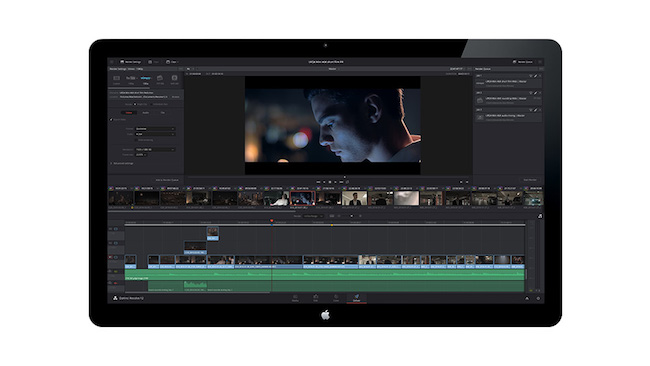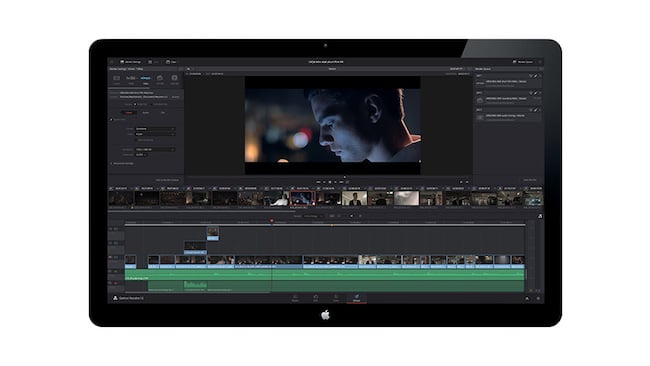
 Resolve 12.5: 1000 enhancements and 250 new features
Resolve 12.5: 1000 enhancements and 250 new features
We mentioned this in passing during last week’s coverage of NAB 2016, but there is so much going on with the latest point release beta of DaVinci Resolve it’s worth diving into it all in a bit more detail.
In fact, most other companies would have simply labelled it as a wholly new version, but Blackmagic always likes to overachieve in this sort of area and thus, despite 1000 enhancements and 250 new features, 12.5 is what it is.
So, the headlines speak of major additions to the editing toolset, new and enhanced colour features, including improved HDR support, and powerful new effects. You can read the detail over the page, but there are definitely a couple of things that stand out for us.
First, this is HDR ready and then some. Specific nodes can now be set to HDR mode which enables the grading tools in Resolve to work in an extended dynamic range especially designed for HDR deliverables. Caching formats such as ProRes 4444 XQ and DNxHR now support extended dynamic range too to serve as an efficient storage alternative to uncompressed 16-bit float files.
Second, there are a lot of workflow tweaks. The ability to overlay the audio waveform onto a video clip, allows users to navigate to different parts of the clip based on a visual cue of peaks and troughs in the audio, which could speed up multiple editing functions. Colorists, meanwhile, will enjoy enhancements to the node editor so now it’s possible to quickly navigate between nodes, swap nodes, select multiple nodes with a lasso, copy node contents, extract nodes, use embedded alpha channels in mattes and more. What’s more, a saved grade from the gallery can be dragged in as a single compound node, or as a fully expanded node tree. There’s also a load of metadata enhancements designed to keep tabs on large scale projects, while new Power Bins in the Media Pool will allow for the easy sharing of stock footage and audio etc between projects.
Third, effects have had a major overhaul with ResolveFX, a new framework for native GPU and CPU accelerated effects. This release includes ResolveFX plug-ins such as GPU accelerated colour space and gamma transformations, along with more traditional effects such as lens blur, light rays, etc (though the funkier stuff is reserved for the Studio edition). Fusion Connect also improves the interoperability with the company’s Fusion compositor.
There’s a whole raft of other stuff as well. You can read the rather long and rather detailed press release about it all over the page.
Blackmagic Design Releases Public Beta for DaVinci Resolve 12.5
SlideDownload ImageSlideDownload ImageSlideDownload ImageSlideDownload Image
NAB 2016, Las Vegas, USA - April 18, 2016 - Blackmagic Design today announced the availability for immediate download of the public beta for DaVinci Resolve 12.5.
DaVinci Resolve 12.5 is a massive update with over 1,000 enhancements and 250 new features which includes major additions to the editing toolset, new and enhanced color features, including improved HDR support, and powerful new effects. DaVinci Resolve 12.5 beta is available now for download from the Blackmagic Design website.
DaVinci Resolve 12.5 will be demonstrated on the Blackmagic Design NAB 2016 booth at #SL217.
DaVinci Resolve 12.5 is designed to make it easier for professional editors and colorists to work faster and have more creative options than ever before. With millions of editors now using DaVinci Resolve, Blackmagic Design engineers have been gathering feedback from customers and adding the features they’ve asked for. DaVinci Resolve 12.5 adds dozens of new editing and trimming features such as new swap and shuffle edits, seven entirely new trim operations, paste inserts, an expanded edit overlay with ripple overwrites and append edits, and much more. In addition, timeline performance has been greatly improved so editing is faster and the new Cinema Viewer option plays video full screen, making it easier for customers to preview their cut on laptops or systems with a single display.
DaVinci Resolve 12.5 introduces an entirely new way to navigate clips using audio waveforms. The source viewer features a revolutionary audio waveform overlay that allows you to see the audio waveform and video clip at the same time. This is the fastest way to navigate to different parts of a clip based on spikes, silent areas or other visual cues in the audio waveform.
DaVinci Resolve 12.5 also adds dozens of new media management and metadata features that make it easier for both assistants and editors to organize and work with massive amounts of media. A new metadata keyword dictionary makes it easier to choose common or previously created keywords and quickly apply them to clips. Metadata can now also be imported or exported via CSV files. Media Pool metadata columns can also be customized and saved, colors can be assigned to specific clips, and markers can now be single frame or durational. Display names, which are used throughout the software, can be automatically created based on metadata tags such as scene, shot and take information, saving editors hours when importing and working with large amounts of footage. New Power Bins in the Media Pool allow sharing of content between projects, making them perfect for graphics, stock footage and sound effect or music libraries that are used across multiple projects.
SlideDownload ImageSlideDownload ImageSlideDownload ImageSlideDownload Image
DaVinci Resolve 12.5 introduces an entirely new way to create custom retime effects and speed ramps. There are now separate curves for both frame position and playback speed. This allows any frame to be moved to any point in time, while also allowing variable speed changes between any range of frames. These powerful new controls make it easier to create unique retiming effects that were never possible before.
The timeline curve editor has been improved so customers can now select, move, and edit groups of multiple keyframes at the same time. There are also new visual controls for adding or selecting keyframes, as well as a menu for selecting specific parameters and curves to edit.
For colorists, DaVinci Resolve 12.5 introduces major enhancements to the node editor so now it’s possible to quickly navigate between nodes, swap nodes, select multiple nodes with a lasso, copy node contents, extract nodes, use embedded alpha channels in mattes and more. When dragging a saved grade from the gallery, customers now have the option to drag the grade in as a single compound node, or as a fully expanded node tree. These changes allow professional colorists to work even faster, while also making it more intuitive for video editors that are learning how to use Resolve’s massive set of color correction tools. In addition, there is a new single point tracker, new temperature and tint sliders have been added to the primary grading controls, additional XRite Colorchecker charts are now supported in the Color Match palette and customers can now select and modify multiple control points at the same time when working with Power Curve Windows.
With cameras such as Blackmagic Design’s URSA Mini 4.6K that already shoot with the latitude needed for HDR work, DaVinci Resolve 12 has already been used to grade more HDR content than any other system. DaVinci Resolve 12.5 Studio now includes major advances in HDR grading controls. Specific nodes can now be set to HDR mode which enables the grading tools in Resolve to work in an extended dynamic range especially designed for HDR deliverables such as Dolby Vision and HDR10. In addition, caching formats such as ProRes 4444 XQ and DNxHR now support extended dynamic range to serve as an efficient storage alternative to uncompressed 16-bit float files. These enhancements mean Blackmagic Design is the only company that offers a complete end to end HDR workflow from on set production to post production.
SlideDownload ImageSlideDownload ImageSlideDownload ImageSlideDownload Image
DaVinci Resolve 12.5 also introduces ResolveFX, a powerful new framework for native GPU and CPU accelerated effects. This release includes ResolveFX plug-ins such as GPU accelerated color space and gamma transformations, along with more traditional effects such as lens blur, light rays, emboss, dent, vortex, mirrors, gaussian and other blurs, glows, ripples, and more. Advanced ResolveFX tools like film grain, lens blurs and flares are available with DaVinci Resolve 12.5 Studio.
For more advanced visual effects work, the new Fusion Connect feature lets customers send clips to Fusion for additional visual effects. Fusion is Blackmagic Design’s advanced node based 3D compositing, visual effects and motion graphics software. When scenes are rendered out of Fusion, they automatically replace the clips on Resolve’s timeline. As effect shots are completed, the Fusion Connect clips in the Resolve timeline can be refreshed to show the most current version of the shot.
The Deliver page has been completely redesigned so now it’s easier to find presets, customize render settings and organize jobs. The new icon browser lets customers see and select output presets which include a new Premiere Pro export, along with presets for ProTools, Avid, Final Cut Pro, Vimeo, YouTube and more. In addition, audio can now be output independently of video as single or multichannel, and clips can be exported with an alpha channel when using supported codecs such as ProRes 4444, ProRes 4444 XQ and uncompressed RGBA.
In addition to all of the above features, DaVinci Resolve 12.5 Studio customers will also get dramatically improved spatial noise reduction which uses a superior multi GPU accelerated algorithm to reduce noise while retaining incredible detail. When combined with DaVinci Resolve 12.5’s enhanced temporal noise reduction controls, customers get the ultimate noise reduction toolset. DaVinci Resolve 12.5 Studio customers also get a new automatic correction tool for fixing barrel, pin cushion or perspective lens distortion, along with high quality de-interlacing, support for Camera LUTs, the DaVinci Color Transform Language (.dctl), and the ability to create ProRes remote render jobs on Windows machines. Customers can even use a terminal command to run a headless version of DaVinci Resolve without the GUI for remote rendering.
SlideDownload ImageSlideDownload ImageSlideDownload ImageSlideDownload Image
“The overwhelming success of DaVinci Resolve 12 has been incredibly exciting. Originally we planned DaVinci Resolve 12.5 to be focused on all the little things that make colorists' and editors' lives more productive, however its turned out that DaVinci Resolve 12.5 has become a major upgrade with a huge number of innovative new features,” said Grant Petty, CEO, Blackmagic Design. “I’d like to thank everyone for their huge support and positive feedback. This year we really wanted to take the time to address all of the finer details and the little things that make a huge difference to the pros that use it everyday, as well as new users learning the software. DaVinci Resolve 12.5 now includes virtually every imaginable editing and trimming tool! We are really excited about how quickly editors are switching, and we are committed to continue making it the best editing and color correction software in the world!”
Availability and Price
The public beta of DaVinci Resolve 12.5 and DaVinci Resolve 12.5 Studio are now available for download from the Blackmagic Design website free of charge for all current DaVinci Resolve customers.
Tags: Post & VFX



Comments